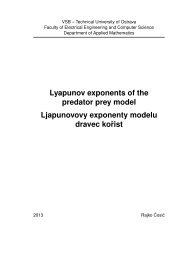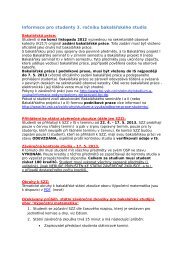The Boundary Element Method for the Helmholtz Equation ... - FEI VÅ B
The Boundary Element Method for the Helmholtz Equation ... - FEI VÅ B
The Boundary Element Method for the Helmholtz Equation ... - FEI VÅ B
You also want an ePaper? Increase the reach of your titles
YUMPU automatically turns print PDFs into web optimized ePapers that Google loves.
792002000.81500.81500.60.41000.60.41000.2500.2500−0.200−0.20−0.4−50−0.4−50−0.6−0.8−100−0.6−0.8−100−0.500.50.5(a) Real part.0−0.5−150−200−0.500.50.5(b) Imaginary part.0−0.5−150Figure 5.5: Solution to <strong>the</strong> interior Neumann BVP inside <strong>the</strong> cube with E = 1200.In Tables 5.4, 5.5, 5.6 we summarize <strong>the</strong> results. <strong>The</strong> error columns are now given byErr D := ∥g D − g D,h ∥ L 2 (∂Ω)∥g D ∥ L 2 (∂Ω), Err D,p := ∥g D − g D,p ∥ L 2 (∂Ω), Err ϑ := ∥u − u h∥ L 2 (ϑ)∥g D ∥ L 2 (∂Ω)∥u∥ L 2 (ϑ)(5.5)with g D , g D,h , g D,p denoting <strong>the</strong> exact, computed and L 2 projected Dirichlet data, respectively.Note that <strong>the</strong> error of <strong>the</strong> computed solution cannot be lower than <strong>the</strong> errorcorresponding to <strong>the</strong> L 2 projected function. Again, ϑ: [0, 1] → R 3 denotes <strong>the</strong> curve (5.4).See pictures 5.4, 5.5 <strong>for</strong> <strong>the</strong> solution on <strong>the</strong> cube and on a grid placed inside.5.3 Interior Mixed <strong>Boundary</strong> Value ProblemLet us now consider <strong>the</strong> interior mixed boundary value problem (3.37) with κ = 2 and <strong>the</strong>testing solution (5.1). For Ω we choose <strong>the</strong> sphere {x ∈ R 3 : ∥x∥ ≤ 1} withΓ D := {x ∈ R 3 : ∥x∥ = 1 ∧ x 3 > 0}, Γ N := {x ∈ R 3 : ∥x∥ = 1 ∧ x 3 < 0}and <strong>the</strong> cube with three sides belonging to Γ D and <strong>the</strong> remaining part belonging to Γ N .To solve <strong>the</strong> mixed problem and to find <strong>the</strong> missing Cauchy data we use <strong>the</strong> discretizedGalerkin equations related to <strong>the</strong> symmetric <strong>for</strong>mulation (3.41), i.e.,a(s h , t h , ψ k , ϕ l ) = F (ψ k , ϕ l )<strong>for</strong> all k ∈ E D , j ∈ N Nwith <strong>the</strong> matrix <strong>for</strong>mulationVκ,h −K κ,h s=D κ,h tK T κ,h121−¯V ¯M κ,h 2 h + ¯K κ,h gN¯M T h − ¯KT κ,h−¯D κ,h g D.









